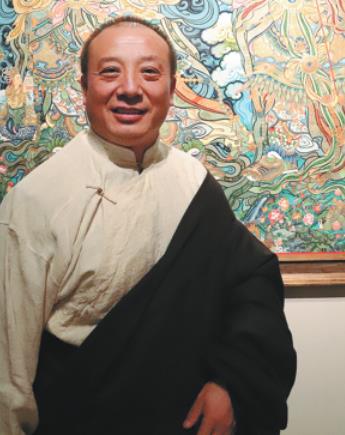Thangka master paints picture of peace at UN headquarters


Tranquil start
Nyangbon recites sutras every morning to start his day in a tranquil way. He said an excellent thangka painter is, first and foremost, a devout practitioner of Buddhism.
"With day-to-day recitations, the Buddhist principles are being imperceptibly transferred to my spiritual world. As a result, this kind of peaceful state of mind will make my painting stroke a peaceful one as well," he said.
Before he starts to paint, he washes his hands and sits cross-legged, keeping his mind in a "respectful, silent and undistracted state".
"How peaceful you are and how much passion and love you are pouring into the painting determine the value of the art work," Nyangbon said.
"Every piece of my artwork is a perfect dialogue between the flesh and the spirit. Only by doing so can we present a meticulous and grand world with our paint brushes."
Nyangbon said he has always regarded painting thangka as a solemn and dedicated religious practice. "The painting process is a process of reunderstanding Buddhism, and a process of reunderstanding and re-examining the world."
The UN is not an unfamiliar place for Nyangbon who, together with Chinese pianist Lang Lang, was warmly welcomed by former UN secretary-general Ban Ki-moon in 2014. Ban's gracious demeanor and scholarly ways, and what the UN was doing to improve people's livelihoods, left a deep impression on Nyangbon.
Ambitious scroll
A State-level master of arts and crafts, Nyangbon began learning thangka painting at the age of 12.
Thangka refers to a mounted scroll painting that is hung in a monastery or over a family altar and sometimes carried by monks during religious events.
It is a distinctive painting style that covers many aspects of Tibetan life such as history, politics, culture and society.
Nyangbon runs the Regong Painting Academy that has many students from poor families. The academy, founded in 2006, has become a major teaching center for thangka painters.
Nyangbon said his apprentices are typically middle school graduates, as a nine-year education is compulsory in China. He believes education helps artisans become accomplished artists.
Regong art was made part of UNESCO's list of intangible cultural heritage in 2009.
"Thangka belongs to China and the world as well. As an inheritor of this art form, it is my responsibility to promote and carry forward this unique art," Nyangbon said.
Five years ago, he launched an ambitious project to paint a 1,000-meter-plus scroll that shows the development of Tibetan Buddhism and a wide spectrum of its culture.
Nyangbon, the scroll's chief designer and lead painter, has been working with dozens of senior thangka painters. So far, the team has completed more than 600 meters of the painting.
"I wish I could bring the giant painting to the UN when it is finished. What I really want to bring to the world is not merely the painting, but the spirit behind it," Nyangbon said.
Commenting on Nyangbon's artworks at the UN, New Yorker Austin Ricci said: "I didn't know thangka very well, but from Nyangbon's paintings, I have seen something very special-symmetry and balance. The world is now in bad need of symmetry and balance."
MOST POPULAR
- 1 China to ease investment restrictions further for foreign firms
- 2 2024 year in review: China's exhibition highlights
- 3 Chinese customs unveils measures to boost development of western regions
- 4 Beijing opens airport service counters for foreign travelers
- 5 China accelerates efforts to build unified national market
Editors' Picks
 Infographic:
China's foreign trade reaches record high
Infographic:
China's foreign trade reaches record high
 Video:
A gateway to travel in China
Video:
A gateway to travel in China
 Infographic:
A look at China's economy in 2024
Infographic:
A look at China's economy in 2024




